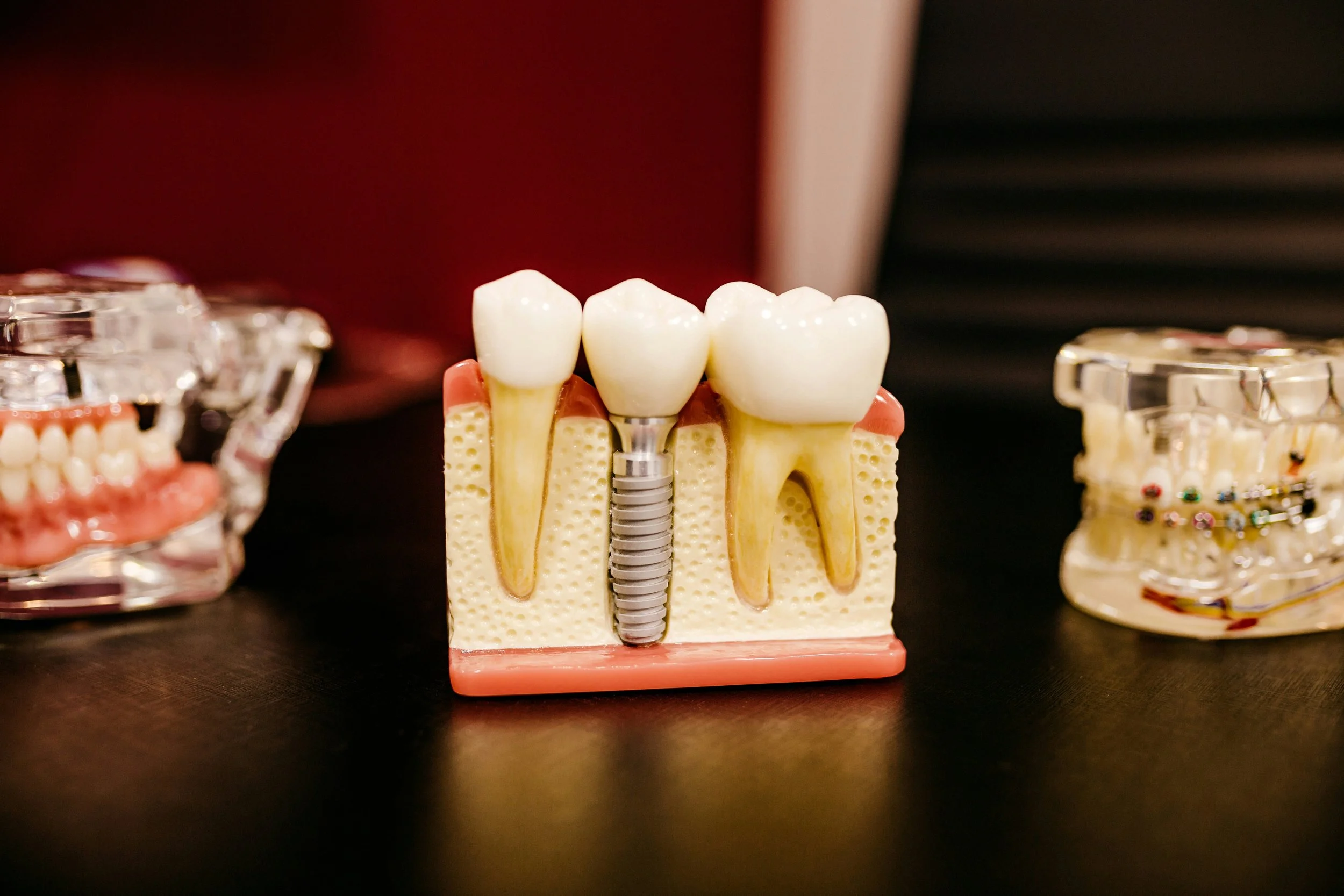implant
If you are missing one or more teeth and wish to eat your favorite foods, increase your chewing ability, and improve your appearance, speech, and self-esteem, then you are a candidate for dental implants.
A dental implant replaces the root of a missing tooth and is made from surgical-grade titanium alloy (Ti 6Al-4V ELI) to exacting specifications. Initially, the implant is placed into the jawbone either immediately after the loss of a tooth, or after an extended period of time. If there is insufficient bone, various bone enhancing procedures can be performed prior to the implant placement. An abutment, which acts as a base for a prosthetic tooth replacement such as a crown, is inserted into the implant at the time of implant placement, or subsequently after a period of healing.
In the past, dentists would try to keep or replace teeth with treatments such as root canals, bridges, and fixed or removable dentures. Unfortunately, a significant number of root canal treated teeth fail, bridges require that healthy adjacent teeth be cut down and removable dentures can often be unstable and require the use of sticky adhesives. Dental implants are a solution to these problems, and many of the concerns associated with natural teeth (including dental decay) are eliminated.
Am I a candidate for an implant?
Dental implants can be a smart choice for adults of all ages. The placement of a dental implant is typically completed in less than an hour, as an office procedure with only local anesthesia. Post-operative discomfort is normally less than that of a tooth extraction. For aesthetic reasons, it is often possible to have a fixed transitional restoration immediately after implant placement so that you are never without a tooth. After a period of three to six months of healing, the temporary healing abutment is removed from the implant and a final abutment is inserted into the implant. A crown or removable denture is secured to this abutment as the final restoration.
implant faqs
-
YES! Not all teeth are good candidates for root canal treatment. Root canal treated teeth are susceptible to decay and fracture, while implants are not susceptible to decay and almost never break. Bicon implants are an excellent and prudent alternative to the root canal, post and core, crown lengthening, and crowning procedures. Often, the cost of saving a tooth with a variety of treatments can exceed that of the placement and restoration of an implant.
-
The implant is machined from surgical-grade titanium alloy (Ti 6Al-4V ELI), which is a biocompatible material. However, there is a slight possibility that it will not integrate with bone. If this were to occur, the implant would be replaced with another one. It is highly unlikely that the second implant would not integrate.
-
Smoking can inhibit proper healing of an implant. However, this does not prevent smokers from having implants successfully placed and restored. You should speak with Dr. Lucero for more specific information relating to your dental needs and the effects of smoking.
-
Usually minimal to none. While undergoing treatment, you will receive local anesthesia. You may have mild post-surgical soreness for up to 72 hours. An over-the-counter pain reliever will alleviate the discomfort for most patients.
-
During treatment, Dr. Lucero may be able to provide you with a transitional prosthesis that will have the look and feel that you need during this period of healing. With an implant, it is often possible to have a fixed transitional tooth immediately after the placement of the implant.
-
A single dental implant placement is usually completed in less than an hour as an office procedure with local anesthesia. The implant is then allowed to heal with the bone for a minimum of eight weeks. If you have poor quality bone and bone-grafting procedures are necessary, the overall process can take up to 12 months or more.
-
Costs vary depending upon your treatment and upon your individual dental needs. In general, implants are not covered by insurance. Detailed questions about your individual needs and how they relate to insurance should be discussed your consultation appointment.
-
Ironically, dental implants require less maintenance than a natural tooth. Simply brush it as though it were a natural tooth.
-
There is no reason why an implant cannot last a lifetime. However, specific situations such as facial or occlusal trauma can negatively impact their longevity.
-
When an upper posterior tooth is lost, the floor of the maxillary sinus drops down into the space formerly occupied by the root of the lost tooth. In order to place an implant, it is often necessary to put the sinus floor back up to where it originally was by adding a synthetic bone substitute. This procedure is called a sinus floor bone augmentation or a sinus lift.
-
After the loss of a tooth, the bone formerly around the tooth is resorbed, often leaving a very narrow ridge of bone. In order to place an implant, the ridge of bone is split as though it were a piece of corrugated cardboard being expanded to provide a wider space between each side. For the upper jaw, this is accomplished at the same time that the implant is placed; the lower jaw requires a second surgical visit approximately three weeks later.
-
A bone graft is a surgical procedure for adding height or width to a jawbone in order to increase its volume for the placement of an implant.

